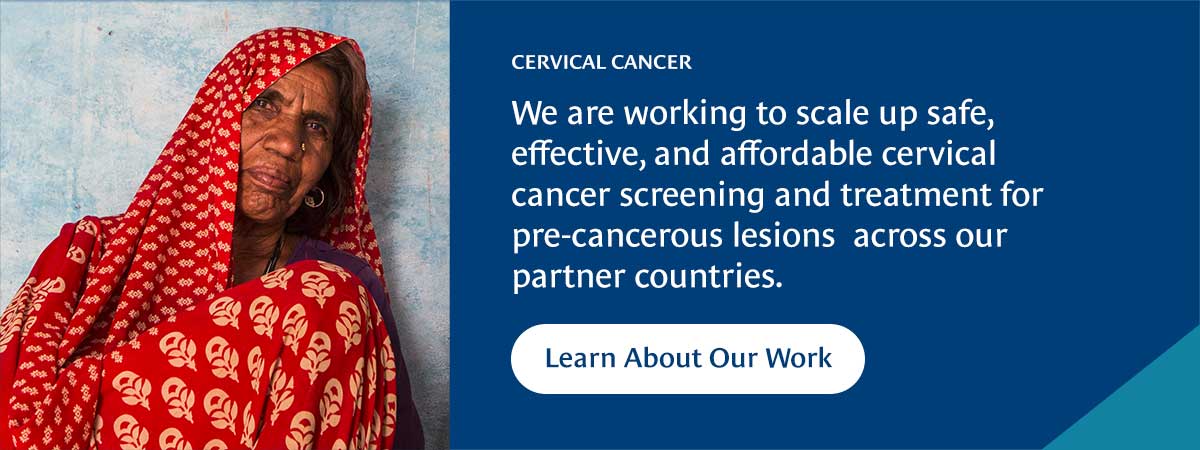CHAI has published a research paper in PLOS ONE presenting findings from a pilot study to assess the feasibility of implementing a near point-of-care (POC) HPV testing model as part of Kenya’s national cervical cancer screening program.
HPV Testing in Preventing Cervical Cancer
Cervical cancer is a global public health concern, causing over 340,000 deaths annually. It is the leading cause of cancer-related mortality in Kenya, claiming at least 3,000 lives in 2020. Cervical cancer is preventable if caught early. Therefore, the Kenyan Ministry of Health (MoH) guidelines and the World Health Organization (WHO) recommend human papillomavirus (HPV) testing, which can detect abnormal cells more effectively than the traditional methods of screening, as the primary method for cervical cancer screening. However, accessibility to HPV testing remains limited within Kenya’s public healthcare system.
GeneXpert in HPV Testing
CHAI, with support from the MoH, conducted a pilot study between October 2019 and December 2020 across nine healthcare facilities in six counties. The study leveraged the GeneXpert platform, originally designed for tuberculosis and HIV testing, for HPV screening. The study also adopted Visual Inspection with Acetic Acid (VIA) to triage HPV-positive cases, in line with national guidelines. Quality assurance was ensured by the National Oncology Reference Laboratory (NORL) using the COBAS 4800 platform. HPV testing involved both self-collected and clinician-collected samples. The research assessed several critical screening performance indicators:
- Screening coverage: The study achieved 27 percent screening coverage among eligible individuals, with the majority (53 percent) falling between 30 to 49 years.
- HPV positivity rate: Within the screened population, nearly 23 percent tested positive for HPV.
- Triage and treatment: Only 10 percent of HPV-positive cases underwent triage with VIA/VILI. Among those triaged, 21 percent tested VIA/VILI positive, and 73 percent received treatment, predominantly through cryotherapy.
- Turnaround time (TAT): The median turnaround time for HPV testing was 24 hours.
- Invalid sample rate: Only two percent of the samples were reported invalid (91 out of 4,500).
- Healthcare worker training: About six percent of healthcare workers (58 out of 1,042) had received cervical cancer screening and treatment training. Furthermore, the majority of those trained were not stationed at service provision areas.
Challenges and Opportunities
While the study shows it is feasible to leverage GeneXpert platform for HPV testing, challenges were noted around low awareness in the community, lack of co-ordination among community health workers and facility providers, poor linkage between clinicians and laboratory personnel who run HPV tests, resulting in delays in test turnaround time, high-loss to follow-up among women, and low retention rates of trained human resource personnel at screening sites.
Community-based strategies offer opportunities for community education and supporting self-sample collection at the community level, an approach found to be more acceptable to women especially in communities with strong cultural beliefs and women not presenting to the health facilities. The study also noted that to tackle high rates of loss to follow-up among HPV-positive women, effective communication of their results and follow-up requires the use of innovative m-health strategies and a streamlined health information system that ensures women return to facilities for linkage to care.
In conclusion, the study presents compelling evidence that near-POC care HPV testing can be successfully executed on the GeneXpert platform. However, to enhance the implementation of GeneXpert-based HPV screening and other near POC platforms across Kenya, it is imperative to strengthen the screening-triage-treatment cascade, bolster the capacity of testing platforms and availability of tests, and address the challenges identified. These improvements are essential steps to combating the significant burden of cervical cancer in Kenya and ultimately saving lives through early detection and treatment.






